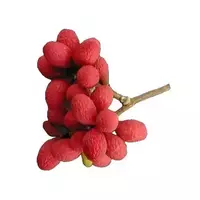Corlan

A representative of the Sapidin family is the corlan plant, which is widespread in the countries of Southeast Asia. As a rule, corlan is cultivated in India, Cambodia, Indonesia, Australia, Africa and the Philippines. However, more of these trees are in Thailand, whose inhabitants greatly appreciate and love the plant.
Corlan is grown similar to such fruit trees as rambutan and pulasan, but the fruit of this plant is characterized by a significant difference - its peel does not have fleshy fibers characteristic of the mentioned fruits. However, the fruits of the corlan tree, like its relatives, are distinguished by a round oval shape and they are collected 20-30 pieces into clusters.
The corlan plant, along with other Sapidinov representatives, prefers to grow on well-moistened soil, in a mild and warm climate. Corlan trees begin to bear fruit in the fifth or sixth year of life, while the maximum harvest can be removed only after almost twenty years. In addition, in order to obtain a good harvest, it is necessary that during the year the rainfall level is at least 2500 mm.
Mature corlan fruits differ in the red color of the peel, and inside the fruit there is a rather tasty mass of gelatinous consistency. Corlan fruits are eaten by pre-peeling them with a knife. By the way, you can eat them both fresh and canned. In their homeland, corlan fruits are an indispensable component of tropical salads. In addition, they are often used to prepare compote, various jams, as well as as an additive to ice cream.
It is noteworthy that the bone of corlan fruits can be used only after heat treatment due to the fact that it is considered poisonous in raw form. The oil that is obtained from these seeds is actively used for the production of cosmetics and soap.
The chemical composition of corlan fruits is almost identical to that of rambutan fruit. For example, they contain a lot of carbohydrates and a certain amount of proteins. In addition, they also have calcium, phosphorus, iron, ascorbic acid. In folk medicine, corlan fruits are used as a natural remedy in order to regain strength after suffering diseases, as well as to normalize blood composition. It has been proven that the daily use of only 5 corlan fruits helps to reduce the risk of developing cancer.
In general, this fruit is very popular in eastern countries, but corlan fruits are often exported to other states where there is no opportunity to grow these trees. A distinctive feature of corlan fruits is their increased tenderness, so they are characterized by short shelf life. So, even under the most favorable conditions, fruits remain fresh for no more than seven days.
corlan 82 kCal
Energy value of corlan (Ratio of proteins, fats, carbohydrates - ju):
Proteins: 0.65 g (~ 3 kCal)
Fats: 0.2 g (~ 2 kCal)
Carbohydrates: 18g (~ 72kCal)
Energy ratio (bj | y): 3% | 2% | 88%
 Español
Español Français
Français Português
Português Русский
Русский 简体中文
简体中文 繁體中文
繁體中文 日本語
日本語 한국어
한국어 العربية
العربية Türkçe
Türkçe Қазақ
Қазақ Deutsch
Deutsch Italiano
Italiano Українська
Українська
